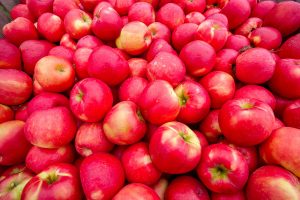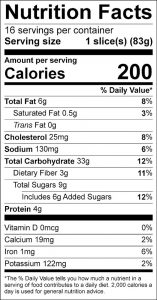Bulletin #4262, Vegetables and Fruits for Health: Apples

Updated and revised by Extension Professor Louise O. Kirkland, University of Maine Cooperative Extension.
Originally developed by Extension Nutrition Specialist Nellie Hedstrom, University of Maine Cooperative Extension.
For information about UMaine Extension programs and resources, visit extension.umaine.edu.
Find more of our publications and books at extension.umaine.edu/publications/.
People in Maine love apples. They are versatile, convenient, readily available year-round, nutritious, and delicious. No wonder the average Mainer eats about 120 apples a year!
Apples provide an easy way to get more fruit in our diets. They are a convenient snack to eat “as is” while on the go. They are also wonderful additions to a wide variety of dishes from soups to desserts.
Nutrition Information
Fresh apples are low in calories, with only about 75 calories in a small apple. They are also a good source of fiber, and virtually fat free. In fact, they are considered a “healthy-heart” food due to their soluble fiber, which has a cholesterol-lowering effect. Amounts of vitamin C and potassium are also found in apples. One small apple or one cup of sliced or chopped raw or cooked apple counts as a one-cup serving of fruit.
Selection
A number of varieties are grown in Maine, including McIntosh, Cortland, Macoun, Golden Delicious, Empire, Jonagold, Ginger Gold, Northern Spy, Jonathan and Honey Crisp. Choosing one for a particular use is largely personal preference, but some varieties are noted for certain qualities.
Cortland is sweet with a hint of tartness. It resists browning so is excellent for salads, as well as snacking, pies, sauce, baking, and freezing.
McIntosh is sweet and juicy. The texture is less firm than some varieties. It is excellent for snacking, pies and sauce, and good for salads and freezing.
Golden Delicious is a sweet, all-around variety excellent for snacking, salads, pies, sauce, baking, and freezing.
Jonagold is honey sweet. It’s an excellent variety for snacking, salads, sauce, and baking, and good for pies and freezing.
Northern Spy is a tart apple excellent for snacking, pies, sauce, and baking, and good for salads.
Ginger Gold and Empire are sweet, making them excellent for snacking and salads, and good for pies, sauce, and baking.
Jonathan is a tart apple considered excellent for snacking, salads, pies, sauce, and baking, and good for freezing.
Red Delicious and Macoun are sweet and juicy, making them good for snacking and salads.
Honey Crisp has a juicy sweet/tart flavor. It is excellent for snacking, salads, pies, sauce, and freezing, and good for baking.
Try picking apples at an orchard near you in the fall. Local apples are also readily available at many stands and farmers markets. Make sure apples are from an orchard that is free of livestock. Choose apples with firm flesh and tight, smooth, unbroken skins. Avoid bruises and rotten spots.
Storage
Handle apples gently. Bumps and bruises can lead to dark, soft spots. Apples should not be left at room temperature. Store them in a cool, dry place, or keep them in a plastic bag in the refrigerator crisper. Poke several holes in the bag for ventilation. Apples absorb odors from other foods, so remember to keep them separated from strong foods such as onions, garlic, and turnips. Properly stored, most varieties will keep from four to six weeks. Check often and remove any apples that are beginning to show decay.
Preparation
Always wash apples before eating or cooking. Whenever possible, don’t peel apples. Two thirds of the fiber and many of the antioxidants are found in the apple’s peel. Apple flesh browns quickly when exposed to air. To prevent this, use acidic juice—such as lemon, orange, or pineapple—to coat the cut fruit, or cover pieces with water while preparing a recipe.
Apple Coleslaw
Serves 6
1 cup chopped or shredded red cabbage
1 cup chopped or shredded green cabbage
1/2 cup chopped or shredded carrot
1 diced apple
2 tablespoons raisins
2 tablespoons cider vinegar
3 tablespoons unsweetened apple juice concentrate
1/2 cup low-fat mayonnaise
Pepper to taste
- In large bowl, combine the two types of cabbage with the carrots, apples, and raisins.
- Mix together the remaining ingredients and add to the cabbage mixture. Toss well. Cover and refrigerate for at least 30 minutes before serving.
Apple Cake
Serves 16
1/2 cup water, apple juice, or cider
1/4 cup canola oil
1/4 cup nonfat vanilla or lemon yogurt
1/2 cup sugar
2 eggs
2 teaspoons vanilla
2 unpeeled apples, finely chopped
1 1/2 cups flour
1 1/2 cups whole wheat pastry flour
1 1/2 teaspoon baking soda
3/4 teaspoon cinnamon
3/4 teaspoon nutmeg
1/4 cup chopped nuts
- In a large bowl, mix ingredients in order given.
- Pour into greased tube pan.
- Bake at 325° F for about 35 minutes.
- Let cake cool before removing from pan.
Some content adapted with permission from University of Massachusetts Cooperative Extension.
Information in this publication is provided purely for educational purposes. No responsibility is assumed for any problems associated with the use of products or services mentioned. No endorsement of products or companies is intended, nor is criticism of unnamed products or companies implied.
© 2008
Call 800.287.0274 (in Maine), or 207.581.3188, for information on publications and program offerings from University of Maine Cooperative Extension, or visit extension.umaine.edu.
In complying with the letter and spirit of applicable laws and pursuing its own goals of diversity, the University of Maine System does not discriminate on the grounds of race, color, religion, sex, sexual orientation, transgender status, gender, gender identity or expression, ethnicity, national origin, citizenship status, familial status, ancestry, age, disability physical or mental, genetic information, or veterans or military status in employment, education, and all other programs and activities. The University provides reasonable accommodations to qualified individuals with disabilities upon request. The following person has been designated to handle inquiries regarding non-discrimination policies: Director of Equal Opportunity, 5713 Chadbourne Hall, Room 412, University of Maine, Orono, ME 04469-5713, 207.581.1226, TTY 711 (Maine Relay System).



